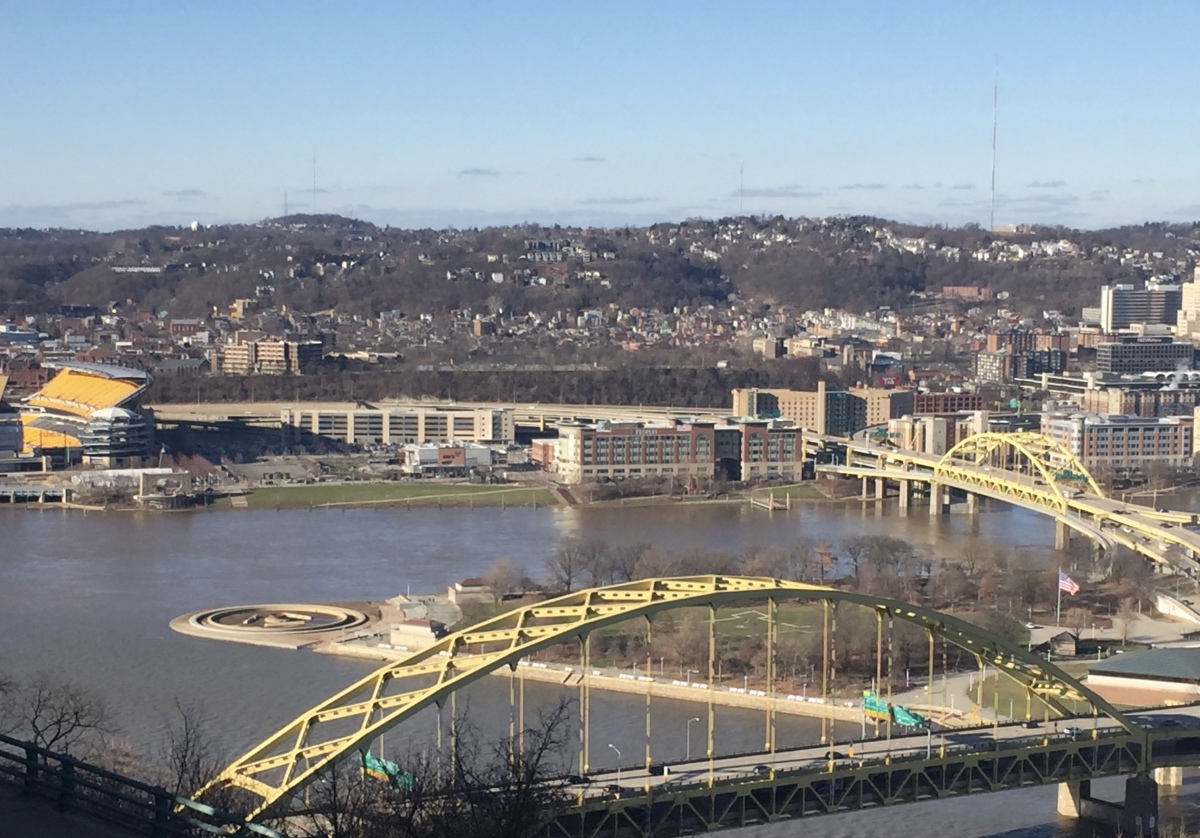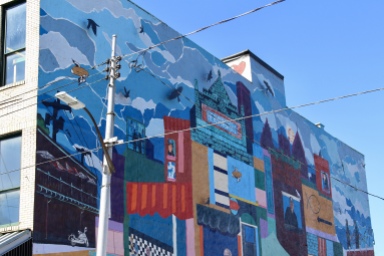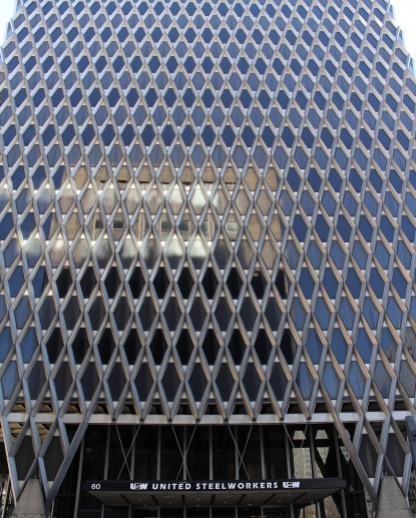The only thing that can be guaranteed in life is that nothing will ever stay the same. Pittsburgh’s Historic Strip District was originally an industrial hub with trains running down the street center. Mills, foundries and glass factories dominated in the 1820s and 1830s. Steel mills pumped out steel and Alcoa produced aluminum. An Air Brake factory, built in 1869, has now become Pittsburgh’s Opera. A 1901 cork factory has been transformed into stylish lofts. Produce wholesalers, once dominant, were eventually nudged out of business due to a chain of events including the Great Depression, the flood of 1936 and WWII, which caused food supply shortages. Large grocery chains began to buy directly from growers.
In the Strip, some companies have hung on and still thrive after over 100 years, such as Pennsylvania Macaroni Company, begun in 1902. Now the Strip is a bustling area of restaurants, markets and shops owned by immigrants of every nationality, from Italians, Greeks and other European immigrants to Asian, Middle Eastern, African, Mexican and others.
And then, of course, there is Pamela’s Diner, which is known to serve the best breakfast in Pittsburgh with its crepe style pancakes. Though we tried to go there for lunch on Saturday and breakfast on Sunday, the lines were too long. Both times, we gave up and went elsewhere.
From The Strip, we walked all through downtown and to Point State Park and back again, putting in 9 miles of walking!
We took a self-guided tour among historic buildings. The August Wilson Center for African-American Culture, built in 2009, celebrates the region’s black heritage and is a performing arts center as well. It is named for playwright August Wilson (1945-2005), who wrote a 10 play series referred to as the Pittsburgh Cycle; each play depicts African American life in a different decade of the 1900s.

August Wilson Center for African-American Culture
The Omni William Penn Hotel, the oldest hotel in the city, was renovated extensively in 2004. The Union Trust Building sits on the site of three churches, and was once a shopping and office complex known as the Union Arcade. Its shops are long gone. The unusual Allegheny Courthouse and Jail was once named for its architect as Richardsonian Romanesque. The jail was closed due to a class action suit by a prisoner and was converted to the family division of the court in 1995. The 1953 31-story Regional Enterprise Tower was once headquarters for Alcoa until that company moved its HQ to the North Shore. Trinity Cathedral and First Presbyterian Church sit across the street from the famous 1873 Duquesne Club, Pittsburgh’s oldest private club, frequented by Pittsburgh’s titans of industry. Dubbed “the citadel of Pittsburgh tycoonery” by Time magazine in 1940, it finally started admitting women in 1980. PPG Place was built to show off its product, glass, and is a neo-Gothic castle with 231 spires covering several city blocks (Moon Handbooks Pennsylvania).
Point State Park marks the point where the Allegheny and the Monongahela merge to create the mighty Ohio River. The British and French fought over it in the latter half of the 18th century. Then British victors and Native Americans fought over it. Now the park offers festivals, concerts, and fireworks displays. Across the Allegheny, we can see two big Pittsburgh stadiums, Heinz Field, home of the Pittsburgh Steelers, and PNC Park, home of the Pittsburgh Pirates.
The yellow Three Sisters Bridges, virtually identical, connect Downtown with the North Side, and all can be crossed on foot. Built between 1924-1928, they are named for famous locals: Roberto Clemente Bridge, named for the National Baseball Hall of Famer; the Andy Warhol Bridge, named for the Pittsburgh pop artist; and Rachel Carson Bridge, named for the nature writer whose 1962 Silent Spring initiated the contemporary environmental movement.
On the other side of the Andy Warhol Bridge sits the current Alcoa Headquarters.

Alcoa
By the time we finish our walk, our feet and legs are awfully sore, so we drive to Grandview Avenue and West End Overlook to see the city from South Side.

Fort Pitt Bridge, Point State Park, Heinz Field and Roberto Clemente Bridge from Grandview Avenue
The 2006 Point of View sculpture shows George Washington and the Seneca leader Guyasuta in a face-to-face meeting in October 1770; the two men met while Washington was in the area scouting land for future settlement along the Ohio River.

Point of View (2006)

Pittsburgh from Grandview Avenue: the Allegheny on the left and the Monongahela on the right. Three Sisters Bridges on the left.
From Grandview Avenue, we drove to West End Overlook, where we saw a limo bus in the parking lot. A couple walked ahead of us in dressy spring clothes with no coats, surprising considering the freezing temperatures. The blonde wore a pink flowered maxi dress split down the front and pink sandals. Her handsome dark-haired boyfriend wore all black. At the top, with the view of the city behind them, they kissed while he took a selfie. Suddenly, shouting and cheers erupted behind us, and a large group of young people dressed to the nines burst out from behind a hill and surrounded the couple, congratulating them on a successful marriage proposal. What a good thing she said yes!

Pittsburgh from West End Overlook
After relaxing with a glass of wine in our Airbnb on South Side, we went to dinner at Church Brew Works, a church converted to a restaurant in Lawrenceville. Here, I enjoyed a Pious Monk Dunkel, a mellow beer with a “clean and roasty aroma and a hint of chocolate flavor” and shrimp with grits with a Cajun cream sauce. Giant brew vats occupied the altar, its walls painted in royal blue. Some of the seats in the restaurant were old pews. The food was fabulous, although it was a bit noisy, packed as it was with families and open-air acoustics.
************************
“PROSE” INVITATION: I invite you to write a 700 to 1,000-word post on your own blog about a recently visited particular destination (not journeys in general). Concentrate on any intention you set for your prose. In this case, I tried to meet some of my intentions: discovering the overlap between history and everyday life, finding the essence of a place, and telling what is surprising about a location. (I don’t recommend setting this many intentions. For my next journey, I hope to simplify.)
You can either set your own writing intentions, or use one of the prompts I’ve listed on this page: writing prompts: prose & poetry. (This page is a work in process.) You can also include photos, of course.
Include the link in the comments below by Monday, May 28 at 1:00 p.m. EST. When I write my post in response to this challenge on Tuesday, May 29, I’ll include your links in that post. My next post will be about our third day in Pittsburgh, and, again, I’ll be using the same intentions. 🙂
This will be an ongoing invitation. Feel free to jump in at any time. 🙂
I hope you’ll join in our community. I look forward to reading your posts!
the ~ wander.essence ~ community
I invite you all to settle in and read a few posts from our wandering community. I promise, you’ll be inspired!
- Suzanne, of Being in Nature, wrote beautifully about humanity in the face of nature in Standing vertical in the storm.
- Jo, of Restless Jo, wrote a fabulous piece that draws us into the life of a Roman soldier: The Roman Army Museum.
Thanks to all of you who wrote prosaic posts following intentions you set for yourself. 🙂
































Another great piece where history and information are beautifully chatty – in your voice. This is something I struggle with. I love your views from above and the diversity of buildings, all towering: also the idea of the Pittsburgh Cycle. You offer a great profile of the city, covering quite an expanse of history.
LikeLiked by 1 person
Thank you, Meg. It was a full day with a lot to cover, and the history is deep and complex. This city is one in which America was built; it’s a hard-working, gritty city that has changed from a pollution-filled powerhouse of industry to a cultural center, yet its grit is still evident on the fringes. It was a lot to cover, still more than I’d like to write. The views from above were amazing.
LikeLike
You can certainly cover the miles city walking, Cathy, but what a great overview. I love the look back at what the city once was and what it’s become. I wondered where you were going with that lady in the pink dress. Such a happy outcome! Love it when things like that happen, right before your eyes. Beautifully captured, Cathy, and many thanks to you for the link and the encouragement. 🙂 🙂 Hope the last lap of your journey runs smoothly and you’re still having fun (and/or experiences 🙂 .
LikeLike
It was such a long day, both in experience and miles, Jo! And a freezing cold day at that. That was why the lady in the pink dress and sandals first caught our eye, and we were utterly surprised by the crowd cheering and emerging from behind the hill. Crazy!
This is to be my last relaxing travel day. I’m driving 2 1/2 hours to Crestone, Colorado to spend the day with Adam, then another 2 hours to Pueblo, CO tonight. Then begins my arduous 3 day drive back east across the country. It won’t be nearly as much fun as coming west!
I enjoyed linking to your fun piece, Jo!
LikeLike
Hope it goes well with Adam. Be kind, Cathy! And take care on the homeward lap.
I’ll be singing along with you. 🙂 🙂
LikeLike
We had a wonderful and very full day! I didn’t get to my hotel in Pueblo until 11:15 last night, after driving in the dark on very remote roads for 3 hours. I was exhausted after it all, but I loved our amazing day!
LikeLike
🙂 🙂
LikeLiked by 1 person
Such an interesting post about Pittsburgh. And the photos are lovely and tell the story of a city in the changing. For me – as a photographer – I know Pittsburgh from the classical photo essay by W. Eugene Smith. Obviously much have changed since then.
LikeLike
Thank you, Otto. I’m not familiar with that photo essay. I’m going to have to check it out! 😊
LikeLiked by 1 person
How very interesting, Cathy. Pittsburgh has always been such a big industrial town that it is good to see how it is developing. And the juxtaposition of being the birthplace of the modern environmental movement while at the same time being a “steel town”, as evidenced by the all those steel-related buildings and monuments, is absolutely fascinating (the steel industries being responsible for a significant proportion of carbon emissions).
LikeLike
Thank you! It was so much fun to explore this ever-changing city, Tracy. Thanks to Rachel Carson and other environmentalists and philanthropists (who my husband said made their fortunes on the glistening backs of the workers), the city has transformed itself. I hope it continues to do so!
LikeLiked by 1 person
I hope it does too, Cathy.
LikeLike
You certainly met your intentions Cathy a great essay in words and photos of how this city has changed so dramatically over the years. I love how you were caught up in the personal touch of the lady in the pink dress. Did you have a good Airbnb this time?
LikeLike
This was our second day in the Airbnb where we locked ourselves in. The Airbnb was fine once we learned not to lock the dead bolt! It was fun to learn how the city transformed itself from an industrial smoke-belting city into a more cultural one! Thanks, Pauline!
LikeLiked by 1 person
What a relief you worked that deadlock out
LikeLiked by 1 person
Who knew that Pittsburgh has become such a beautiful city? Well, my college friend who’s lived there for decades knew and keeps asking me to visit. One of these days…. But on the other hand, I feel like I’ve seen it well thanks to your beautiful photographs. I can almost taste the beer…(any beer with a hint of chocolate flavor must be an excellent beer…)
LikeLike
Thanks Pam. I think you would enjoy visiting Pittsburgh. It certainly has its own unique character. There are definitely many good restaurant and brew choices! 😊
LikeLiked by 1 person
Great buildings, I love the upward angles you have used. By the way, Perks of Being a Wallflower was on TV the other night – very late, or possibly very early the next morning. Anyway, I have recorded it after seeing the clip you posted.
LikeLike
Thanks, Anabel. I hope you like the movie. It’s a cute one but not one of my favorites. It certainly gives one a feel for Pittsburgh! Let me know what you think. It’s a shame I couldn’t stand up through the Fort Pitt Tunnel!
LikeLike
I will let you know! Though as I watch about 2 movies a year don’t hold your breath 😉
LikeLiked by 1 person
So much interesting architecture here and lots of history. Cathy, your photo of the two rivers meeting is great.
LikeLike
Thank you. That was such a fabulous view of the city from across the river, Carol. It was fun to see and photograph! 😊
LikeLiked by 1 person
I love this post, the architecture old and new is fabulous.
LikeLike
Thanks so much, Gilly. Pittsburgh was a surprise all around!
LikeLike
I love Pittsburgh, lost count of how many times I have been. My sister-in-law lives here and so we have been fortunate and got to Pamelas before the queues as she knows exactly when to go. It is good, but not worth the queues!
You have captured many of my favourite places in this city.
LikeLike
Wow, nice to find someone who has been extensively to Pittsburgh. And lucky for you that you got into Pamela’s. It sure helps to have an insider there to help you figure out the secrets to the place! I’m glad you enjoyed seeing pictures of your favorite places. 🙂 Thanks for dropping by, Becky! 🙂
LikeLike
So glad I found you via Jo 😁
LikeLike
I’m glad too, Becky! 🙂
LikeLike
😊
LikeLiked by 1 person